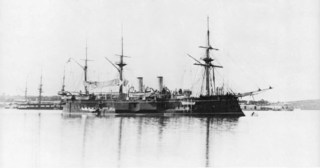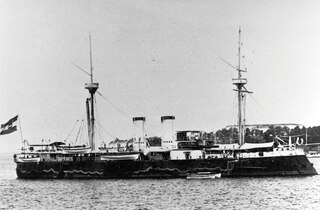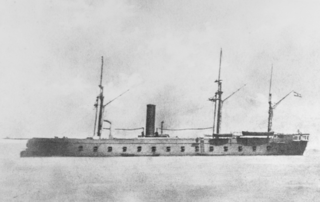
SMS Kaiserin und Königin Maria Theresia was an armored cruiser used by the imperial Austro-Hungarian Navy from 1895 to 1917; she was the first ship of that type built by the Austro-Hungarian Navy. The ship was a unique design, built by the Stabilimento Tecnico Triestino shipyard in Trieste; she was laid down in July 1891, launched in April 1893, and completed in November 1894. Armed with a main battery of two 24-centimeter (9.4 in) guns and eight 15 cm (5.9 in) guns, the ship provided the basis for two subsequent armored cruiser designs for the Austro-Hungarian Navy.

SMS Panther was a torpedo cruiser (Torpedoschiff) of the Austro-Hungarian Navy. She and her sister ship, Leopard were part of a program to build up Austria-Hungary's fleet of torpedo craft in the 1880s. She was the lead ship of her class, and was built in Britain by Armstrong, from her keel laying in October 1884 to her completion in December 1885. She was armed with a battery of two 12 cm (4.7 in) guns and ten 47 mm (1.9 in) guns, along with four 356 mm (14 in) torpedo tubes.

SMS Leopard was a torpedo cruiser (Torpedoschiff) of the Austro-Hungarian Navy. She and her sister ship, SMS Panther, were part of a program to build up Austria-Hungary's fleet of torpedo craft in the 1880s. Both ships, the only members of the Panther class, were built in Britain at the Armstrong shipyard in Elswick. Leopard was laid down in January 1885, launched in September 1885, and completed in March 1886. She was armed with a battery of two 12 cm (4.7 in) guns and ten 47 mm (1.9 in) guns, along with four 356 mm (14 in) torpedo tubes.

SMS Tiger was a torpedo cruiser built for the Austro-Hungarian Navy in the mid-1880s. An enlarged and improved version of the Panther class, she was part of a program to build up Austria-Hungary's fleet of torpedo craft in the 1880s. The Panther class, purchased from a British shipyard, was acquired in part to gain experience building cruisers of the type; this provided the basis for the design of Tiger. She was laid down at the Stabilimento Tecnico Triestino shipyard in October 1886, she was launched in June 1887, and was completed in March 1888. The ship was armed with a battery of four 12 cm (4.7 in) guns and three 35 cm (14 in) torpedo tubes, and was capable of speeds in excess of 19 knots.

SMS Tegetthoff was an ironclad warship of the Austro-Hungarian Navy. She was built by the Stabilimento Tecnico Triestino shipyard in Trieste, between April 1876 and October 1881. She was armed with a main battery of six 28 cm (11 in) guns mounted in a central-battery. The ship had a limited career, and did not see action. In 1897, she was reduced to a guard ship in Pola, and in 1912 she was renamed Mars. She served as a training ship after 1917, and after the end of World War I, she was surrendered as a war prize to Italy, which sold her for scrapping in 1920.

SMS Kaiser was a 92-gun wooden ship of the line of the Austrian Navy, the last vessel of the type, and the only screw-driven example, to be built by the Austrians. She was built by the naval shipyard in Pola; she was laid down in March 1855, was launched in October 1858, and was completed the following year. The ship took part in the Second Schleswig War of 1864, but saw no action during her deployment to the North Sea. Kaiser did see action during the Seven Weeks' War two years later, during which she took part in the Battle of Lissa as the flagship of Anton von Petz, commander of the Austrian 2nd Division. Kaiser engaged several Italian ironclads simultaneously, rammed one—Re di Portogallo—and damaged another—Affondatore—with gunfire. In doing so, she became the only wooden ship of the line to engage an ironclad warship in battle.

SMS Kronprinzessin Erzherzogin Stephanie was an ironclad warship built for the Austro-Hungarian Navy in the 1880s, the last vessel of that type to be built for Austria-Hungary. The ship, named for Archduchess Stephanie, Crown Princess of Austria, was laid down in November 1884, was launched in April 1887 and completed in July 1889. She was armed with a pair of 30.5-centimeter (12 in) guns in open barbettes and had a top speed of 17 knots. Her service was limited, in large part due to the rapid pace of naval development in the 1890s, which quickly rendered her obsolescent. As a result, her career was generally limited to routine training and the occasional visit to foreign countries. In 1897, she took part in an international naval demonstration to force a compromise over Greek and Ottoman claims to the island of Crete. Kronprinzessin Erzherzogin Stephanie was decommissioned in 1905, hulked in 1910, and converted into a barracks ship in 1914. After Austria-Hungary's defeat in World War I, the ship was transferred to Italy as a war prize and was eventually broken up for scrap in 1926.

SMS Prinz Eugen was an ironclad warship built for the Austro-Hungarian Navy in the 1870s, the third and final member of the Kaiser Max class. The ship was supposedly the same vessel that had been laid down in 1861, and had simply been reconstructed. In reality, the head of the Austro-Hungarian Navy could not secure funding for new ships, but reconstruction projects were uncontroversial, so he "rebuilt" the three earlier Kaiser Max-class ironclads. Only the engines and parts of the armor plate were reused in the new Prinz Eugen, which was laid down in October 1874, launched in September 1877, and commissioned in November 1878. The ship spent significant periods out of service, in part due to slender naval budgets that prevented much active use. In 1880, she took part in an international naval demonstration against the Ottoman Empire, and she went to Spain in 1888 for the Barcelona Universal Exposition. Prinz Eugen was stricken in 1904 and converted into a repair ship in 1906–1909. She was renamed Vulkan and served in this capacity through World War I; after the war, she was seized by Italy but was awarded to Yugoslavia in the postwar peace negotiations. Italy refused to hand the ship over, however, and her ultimate fate is unknown.

SMS Don Juan d'Austria was an ironclad warship built for the Austro-Hungarian Navy in the 1870s, the second of the three ships of the Kaiser Max class. The ship was purportedly the same vessel that had been laid down in 1861, and had simply been reconstructed. This was a fiction, however; the head of the Austro-Hungarian Navy could not secure funding for new ships, but reconstruction projects were uncontroversial, so he "rebuilt" the three earlier Kaiser Max-class ironclads. Only the engines and parts of the armor plate were reused in the new Don Juan d'Austria, which was laid down in February 1874, launched in December 1875, and commissioned in October 1876. The ship's career was fairly limited, in part due to slender naval budgets that prevented much active use. She made foreign visits and took part in limited training exercises in the 1880s and 1890s. Long since obsolete, Don Juan d'Austria was removed from service in 1904 and used as a barracks ship through World War I. After the war, she sank under unclear circumstances.

SMS Erzherzog Albrecht was an ironclad warship built for the Austro-Hungarian Navy in the 1870s, the only member of her class. Her design was similar to the ironclad Custoza, but Erzherzog Albrecht was built to a smaller size; like Custoza, she was an iron-hulled casemate ship armed with a battery of eight heavy guns. The ship was laid down in June 1870, was launched in April 1872, and was commissioned in June 1874. The ship's service career was limited; tight naval budgets precluded an active fleet policy in the 1870s, which did not markedly improve in the 1880s. Her first period of active service came in 1881 and 1882, when she helped suppress a revolt in Cattaro Bay. In 1908, she was converted into a tender for the gunnery training school, having been renamed Feuerspeier. In 1915, she became a barracks ship, and after World War I ended in 1918, was ceded to Italy as a war prize. She was renamed Buttafuoco, served in the Italian Navy as a hulk through World War II before being scrapped in 1950.

SMS Custoza was an ironclad warship built for the Austro-Hungarian Navy in the 1870s, the only member of her class. She was the first Austro-Hungarian ironclad to be built after the navy studied the results of the Battle of Lissa of 1866; she was also the first iron-hulled capital ship to be built for the Austro-Hungarian Navy. She was laid down in November 1869, launched in August 1872, and completed in February 1875. Her career was fairly limited, in part due to reduced naval budgets in the 1870s that also delayed her completion. Custoza was somewhat more active in the 1880s, taking part in an international naval demonstration against the Ottoman Empire in 1880, being modernized in 1882, and a trip to Spain for the Barcelona Universal Exposition in 1888. The ship became a training ship in 1902, was converted into a barracks ship in 1914, and after World War I, was awarded as a war prize to Italy. Custoza was immediately broken up.

SMS Lissa, named for the Battle of Lissa, was a unique ironclad warship built for the Austro-Hungarian Navy in the 1860s and 1870s, the only member of her class. She was the first casemate ship built for Austria-Hungary, she was armed with a main battery of twelve 9-inch (229 mm) guns in a central armored casemate, unlike the earlier broadside ironclads. Construction of the ship lasted from June 1867 to May 1871, and was delayed by budgetary shortfalls; the lack of funding also plagued the ship during her career, preventing her from taking an active role in the fleet. She spent the majority of her time in service laid up in Pola, apart from a lengthy reconstruction in 1880–1881. Lissa was ultimately stricken from the fleet in 1892 and broken up for scrap starting the following year.

The Kaiser Max class of ironclad warships was a group of three casemate ships built for the Austro-Hungarian Navy in the 1870s: Kaiser Max, Don Juan d'Austria, and Prinz Eugen. The three ships were ostensibly the same vessels as the earlier Kaiser Max class, though they were in fact entire new vessels. Only parts of the earlier ships' machinery, armor plating, and other equipment were reused in the new ironclads. The ships were all laid down in 1874; the first two were launched in 1875 and completed in 1876, while work on Prinz Eugen proceeded much more slowly. She was launched in 1877 and completed in 1878. The three ships were armed with a battery of eight 21-centimeter (8.3 in) guns mounted in a central, armored casemate, and were capable of a top speed of 13.28 knots.

The Erzherzog Ferdinand Max class consisted of a pair of ironclad warships—Erzherzog Ferdinand Max and Habsburg—built for the Austrian Navy in the 1860s. They were the last broadside armored frigates to be built for the Austrian Empire, and the last vessels completed to see action against the Italians at the Battle of Lissa in 1866. Intended to have been armed with new breech-loading Krupp guns, the outbreak of the Seven Weeks' War prevented the delivery of the guns, forcing the Austrian Navy to arm the ships with a battery of sixteen older 48-pounder muzzle-loading guns.

The Kaiser Max class of broadside ironclads was a group of three vessels built for the Austro-Hungarian Navy in the 1860s. The class consisted of Kaiser Max, the lead ship, Prinz Eugen, and Juan de Austria. They were an improved version of the preceding Drache class, being larger, carrying a larger gun battery, and having more powerful engines. The three ships were all laid down in 1861, launched in 1862, and completed in 1863.

SMS Kaiser Max was the lead ship of the Kaiser Max class of armored frigates built for the Austrian Navy in the 1860s. Her keel was laid in October 1861 at the Stabilimento Tecnico Triestino shipyard; she was launched in March 1862, and was completed in 1863. She carried her main battery—composed of sixteen 48-pounder guns and fifteen 24-pounders—in a traditional broadside arrangement, protected by an armored belt that was 110 mm (4.3 in) thick.

SMS Prinz Eugen was the second member of the Kaiser Max class built for the Austrian Navy in the 1860s. Her keel was laid in October 1861 at the Stabilimento Tecnico Triestino shipyard; she was launched in June 1862, and was completed in March 1863. She carried her main battery—composed of sixteen 48-pounder guns and fifteen 24-pounders—in a traditional broadside arrangement, protected by an armored belt that was 110 mm (4.3 in) thick.

SMS Don Juan d'Austria was the third member of the Kaiser Max class built for the Austrian Navy in the 1860s. Her keel was laid in October 1861 at the Stabilimento Tecnico Triestino shipyard; she was launched in July 1862, and was completed in 1863. She carried her main battery—composed of sixteen 48-pounder guns and fifteen 24-pounders—in a traditional broadside arrangement, protected by an armored belt that was 110 mm (4.3 in) thick.

The Panther-class was a group of two torpedo cruisers, Panther and Leopard, built for the Austro-Hungarian Navy in the 1880s. The ships' primary armament was their four torpedo tubes, though they also carried a battery of medium and light-caliber guns. The ships were ordered in an effort to strengthen the defensive capabilities of the Austro-Hungarian Navy, during a period where funding for more expensive ironclad warships could not be secured from parliament. Since Austro-Hungarian naval designers did not have sufficient experience designing vessels of the type, the navy ordered the ships from the British Armstrong shipyard; work took from late 1884 to early 1886. After arriving in Austria-Hungary in 1886, the two ships served in a variety of roles. These included active duty with the main fleet in home waters, overseas training cruises, and showing the flag abroad. During World War I, the cruisers were mobilized for coastal defense duties, but saw no major action, apart from Panther shelling Montenegrin forces in 1916. After the war, both vessels were surrendered to Britain as war prizes and were broken up for scrap in 1920.



















